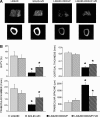Hyponatremia-induced osteoporosis
- PMID: 19751154
- PMCID: PMC3153395
- DOI: 10.1359/jbmr.090827
Hyponatremia-induced osteoporosis
Abstract
There is a high prevalence of chronic hyponatremia in the elderly, frequently owing to the syndrome of inappropriate antidiuretic hormone secretion (SIADH). Recent reports have shown that even mild hyponatremia is associated with impaired gait stability and increased falls. An increased risk of falls among elderly hyponatremic patients represents a risk factor for fractures, which would be further amplified if hyponatremia also contributed metabolically to bone loss. To evaluate this possibility, we studied a rat model of SIADH and analyzed data from the Third National Health and Nutrition Examination Survey (NHANES III). In rats, dual-energy X-ray absorptiometry (DXA) analysis of excised femurs established that hyponatremia for 3 months significantly reduced bone mineral density by approximately 30% compared with normonatremic control rats. Moreover, micro-computed tomography (microCT) and histomorphometric analyses indicated that hyponatremia markedly reduced both trabecular and cortical bone via increased bone resorption and decreased bone formation. Analysis of data from adults in NHANES III by linear regression models showed that mild hyponatremia is associated with increased odds of osteoporosis (T-score -2.5 or less) at the hip [odds ratio (OR) = 2.85; 95% confidence interval (CI) 1.03-7.86; p < .01]; all models were adjusted for age, sex, race, body mass index (BMI), physical activity, history of diuretic use, history of smoking, and serum 25-hydroxyvitamin D [25(OH)D] levels. Our results represent the first demonstration that chronic hyponatremia causes a substantial reduction of bone mass. Cross-sectional human data showing that hyponatremia is associated with significantly increased odds of osteoporosis are consistent with the experimental data in rodents. Our combined results suggest that bone quality should be assessed in all patients with chronic hyponatremia.
Copyright American Society for Bone and Mineral Research.
Figures





References
-
- Upadhyay A, Jaber BL, Madias NE. Incidence and prevalence of hyponatremia. Am J Med. 2006;119:S30–35. - PubMed
-
- Kleinfeld M, Casimir M, Borra S. Hyponatremia as observed in a chronic disease facility. J Am Geriatr Soc. 1979;27:156–161. - PubMed
-
- Hawkins RC. Age and gender as risk factors for hyponatremia and hypernatremia. Clin Chim Acta. 2003;337:169–172. - PubMed
-
- Chen LK, Lin MH, Hwang SJ, Chen TW. Hyponatremia among the institutionalized elderly in two long-term care facilities in Taipei. J Chin Med Assoc. 2006;69:115–119. - PubMed
-
- Miller M, Morley JE, Rubenstein LZ. Hyponatremia in a nursing home population. J Am Geriatr Soc. 1995;43:1410–1413. - PubMed
Publication types
MeSH terms
LinkOut - more resources
Full Text Sources
Other Literature Sources
Medical

